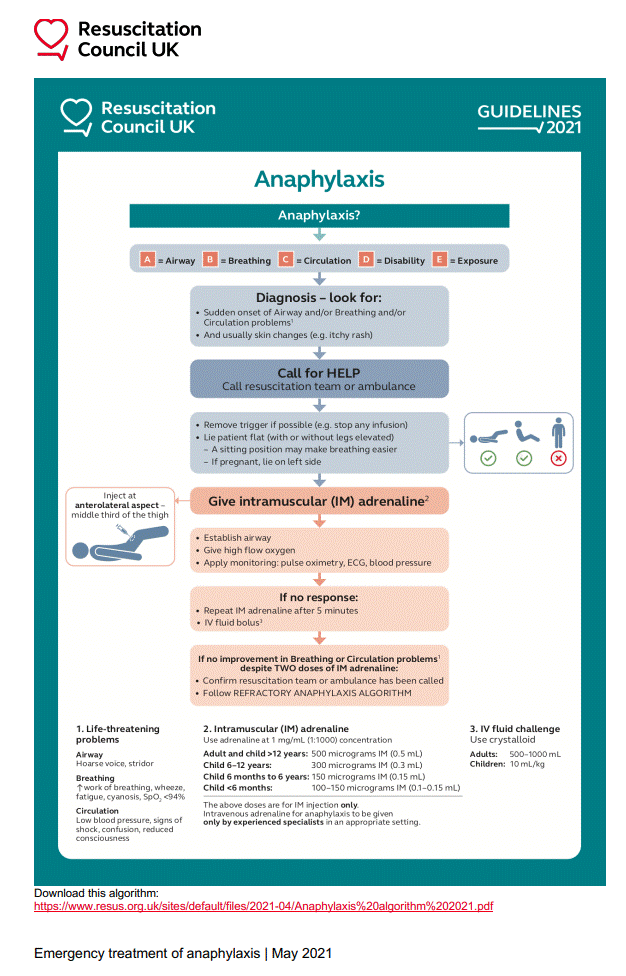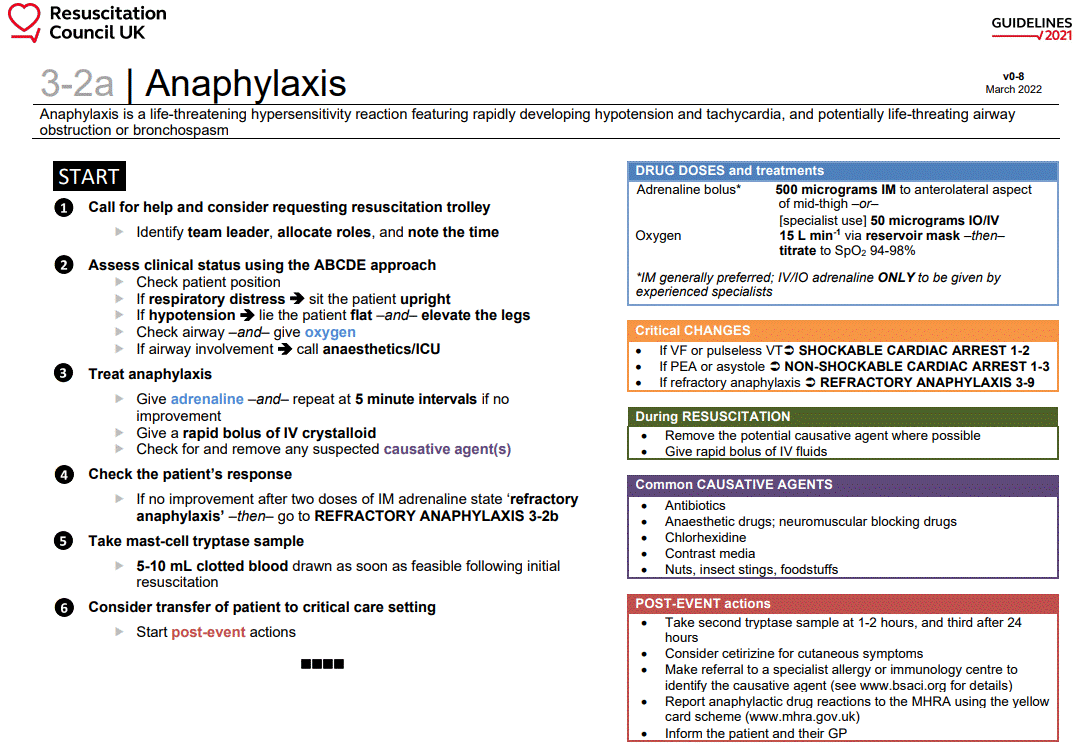Makindo Medical Notes"One small step for man, one large step for Makindo" |
|
|---|---|
| Download all this content in the Apps now Android App and Apple iPhone/Pad App | |
| MEDICAL DISCLAIMER: The contents are under continuing development and improvements and despite all efforts may contain errors of omission or fact. This is not to be used for the assessment, diagnosis, or management of patients. It should not be regarded as medical advice by healthcare workers or laypeople. It is for educational purposes only. Please adhere to your local protocols. Use the BNF for drug information. If you are unwell please seek urgent healthcare advice. If you do not accept this then please do not use the website. Makindo Ltd. |
Anaphylaxis
-
| About | Anaesthetics and Critical Care | Anatomy | Biochemistry | Cardiology | Clinical Cases | CompSci | Crib | Dermatology | Differentials | Drugs | ENT | Electrocardiogram | Embryology | Emergency Medicine | Endocrinology | Ethics | Foundation Doctors | Gastroenterology | General Information | General Practice | Genetics | Geriatric Medicine | Guidelines | Haematology | Hepatology | Immunology | Infectious Diseases | Infographic | Investigations | Lists | Microbiology | Miscellaneous | Nephrology | Neuroanatomy | Neurology | Nutrition | OSCE | Obstetrics Gynaecology | Oncology | Ophthalmology | Oral Medicine and Dentistry | Paediatrics | Palliative | Pathology | Pharmacology | Physiology | Procedures | Psychiatry | Radiology | Respiratory | Resuscitation | Rheumatology | Statistics and Research | Stroke | Surgery | Toxicology | Trauma and Orthopaedics | Twitter | Urology
Related Subjects: |Adrenaline/Epinephrine |Atropine |Adult Resus:Acute Anaphylaxis |Adult Resus:Basic Life Support |Adult Resus: Advanced Life Support |Adult Resus: Obstetric Cardiac Arrest |Newborn/Child Resus: All |Acute Hypotension |Cardiogenic shock |Distributive Shock |Hypovolaemic or Haemorrhagic Shock |Obstructive Shock |Septic Shock and Sepsis |Shock (General Assessment) |Toxic Shock Syndrome |Respiratory failure |Resus:Bradycardia |Resus:Tachycardia |Resus:Hyperkalaemia |Resus:Post Resuscitation Algorithm |Resus:Acute Severe Asthma |Resus:Acute Haemorrhage |
⚡ Anaphylaxis is a severe, life-threatening, generalised or systemic hypersensitivity reaction. 💉 Adrenaline 0.5 mg IM (0.5 mL of 1:1000) into the lateral thigh is first-line and potentially life-saving. 👉 Give promptly, through clothes if needed. Delay in adrenaline = poorer outcomes.
| 🚨 Acute Anaphylaxis |
|---|
🔑 First steps
🩺 Initial Management Summary (Resus UK)
🔥 Refractory Anaphylaxis
|
⚠️ Treat immediately if there are any life-threatening ABC signs: Hoarse voice, stridor, wheeze, ↑ work of breathing, SpO₂ <94%, hypotension, shock, confusion, collapse. 👉 Rash alone is not sufficient, but beware evolving reactions.


🔬 Pathophysiology
- IgE-mediated mast cell/basophil degranulation after allergen cross-linking.
- Massive histamine release → H1: bronchospasm, vasodilation, urticaria. H2: gastric acid, tachycardia. H3/4 modulate CNS & immune cells.
- Increased vascular permeability → angioedema, hypotension.
- Cytokine cascade → further tissue injury + biphasic reactions.
🦠 Common Triggers
- Drugs: penicillin, contrast media, NSAIDs, chemotherapy.
- Foods: peanuts, tree nuts, shellfish, eggs, milk, fish.
- Insect stings (bee, wasp, hornet).
- Blood products in IgA deficiency.
- Latex.
🩺 Differentials
- Septic shock (warm peripheries, infection signs).
- Asthma exacerbation (but no hypotension/urticaria).
- Vasovagal syncope.
- Panic attack.
- Scombroid (histamine fish poisoning).
- Hereditary angioedema (no urticaria, C1 esterase deficiency).
🧪 Investigations
- FBC, U&E, LFTs, ABG, lactate (if shocked).
- Mast cell tryptase within 1h & at 24h. More reliable in drug/sting than food allergy.
- Allergy clinic follow-up: Skin prick test, specific IgE (RAST/ImmunoCAP).
🛡️ Prevention & Education
- Avoid identified allergen (strict dietary, drug alerts, hospital wristbands).
- ⚠️ Always prescribe & teach use of adrenaline auto-injector (EpiPen, Jext, Emerade).
- Educate patient/family on early recognition & action plan.
- MedicAlert bracelet and referral to immunology specialist.
📌 Clinical Pearls
- 💉 Adrenaline IM is safe and life-saving. Do not delay for IV access.
- 🏥 Monitor 6–12h: biphasic reactions occur in up to 20% of cases.
- 📊 Risk factors for fatal anaphylaxis: delayed adrenaline, asthma, beta-blocker use, adolescents/young adults.
- ⚡ IV adrenaline is cardiac arrest only. Outside that, infusion only with senior help.
📚 References
🧑⚕️ Case Examples — Acute Anaphylaxis
- Case 1 (Food allergy — Peanut): 🥜 A 17-year-old boy develops sudden breathlessness, throat tightness, urticaria, and hypotension 5 minutes after eating a peanut bar. Diagnosis: Severe food-induced anaphylaxis. Teaching point: Immediate IM adrenaline 500 micrograms into the anterolateral thigh; repeat every 5 minutes if no improvement. Call 999, lie patient flat, give high-flow O2 and IV fluids if shocked.
- Case 2 (Drug reaction — Antibiotic): 💉 A 62-year-old woman in hospital develops hypotension, widespread rash, and wheeze within minutes of IV co-amoxiclav. Diagnosis: Drug-induced anaphylaxis. Teaching point: Stop the trigger, give IM adrenaline immediately, start ABC resuscitation. NICE: Monitor patient for ≥6–12 h due to risk of biphasic reaction.
- Case 3 (Insect sting): 🐝 A 45-year-old beekeeper stung on the arm develops rapid onset angioedema, stridor, and dizziness. Diagnosis: Anaphylaxis secondary to bee sting. Teaching point: Adrenaline is first-line. Arrange referral to allergy clinic post-stabilisation (venom immunotherapy may be considered).
- Case 4 (Perioperative): 🛏️ A 55-year-old man under anaesthesia develops sudden hypotension and bronchospasm shortly after muscle relaxant administration. Diagnosis: Perioperative anaphylaxis. Teaching point: Immediate adrenaline + IV fluids; involve anaesthetics and allergy team for investigation. NICE: All perioperative suspected anaphylaxis should be referred for specialist testing.
- Case 5 (Late-phase biphasic reaction): ⏱️ A 30-year-old woman treated for nut-induced anaphylaxis with IM adrenaline improves initially, but 8 hours later develops recurrent wheeze and urticaria. Diagnosis: Biphasic anaphylaxis. Teaching point: NICE recommends observation for at least 6–12 h after resolution, and to provide adrenaline auto-injector + written emergency plan at discharge.